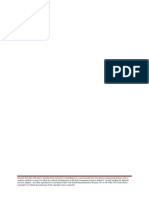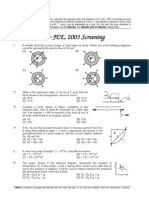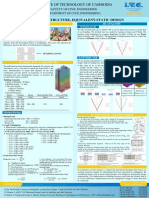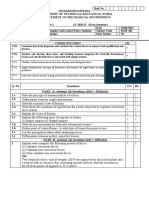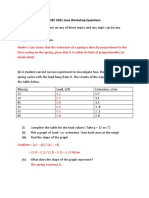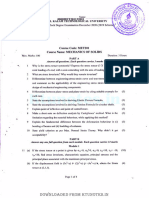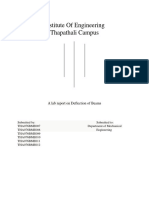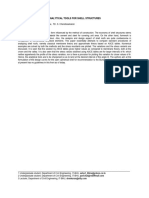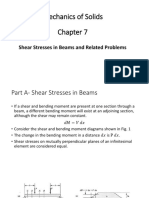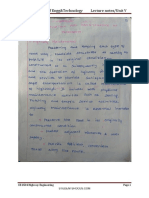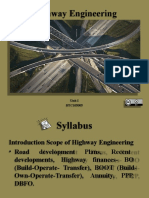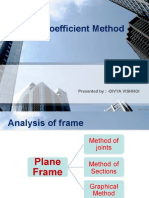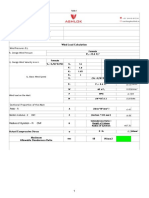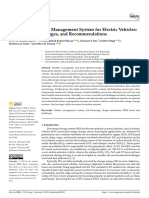TIRUCHIRAPALLI - 621213.: Civil
TIRUCHIRAPALLI - 621213.: Civil
Uploaded by
rpsirCopyright:
Available Formats
TIRUCHIRAPALLI - 621213.: Civil
TIRUCHIRAPALLI - 621213.: Civil
Uploaded by
rpsirOriginal Title
Copyright
Available Formats
Share this document
Did you find this document useful?
Is this content inappropriate?
Copyright:
Available Formats
TIRUCHIRAPALLI - 621213.: Civil
TIRUCHIRAPALLI - 621213.: Civil
Uploaded by
rpsirCopyright:
Available Formats
SRI VIDYA COLLEGE OF ENGINEERING AND TECHNOLOGY COURSE FILE (QUESTION BANK)
TIRUCHIRAPALLI - 621213.
QUESTION BANK
DEPARTMENT: CIVIL SEMESTER: V
SUBJECT CODE / Name: CE 2302 / STRUCTURAL ANALYSIS-I
UNIT 3 – ARCHES
PART – A (2 marks)
1. Write the types of arches based on the number of hinges.
(AUC Apr/May 2012, Nov/Dec 2013, May/June 2014)
Two hinged arch
Three hinged arch
Fixed arch
Four hinged
One hinged
Support reactions
2. What is meant by degree of static indeterminacy of a structure? (AUC Apr/May 2012)
If the conditions of statics i.e., ∑H=0, ∑V=0 and ∑M=0 alone are not sufficient to find either
external reactions or internal forces in a structure, the structure is called a statically indeterminate
structure.
3. Write the difference between circular arch and parabolic arch. (AUC Nov/Dec 2012)
S.No Circular arch Parabolic arch
1 The calculation part is difficult in this The calculation part is easier in this
circular type of arches. parabolic type of arches.
2 The equation to find the height ‘y’ under The equation to find the height ‘y’
the section is under the section is
4 yC R2 = x2 + (R – yC + y)2
y= (L – 2x) Here R can be determined by
L2 2
L
(2RC - yC) yC =
2
4. Give the equation for temperature effect in arches. (AUC Nov/Dec 2012)
l TEI
Horizontal thrust, H = l 2
o y dx
CE6501-STRUCTURAL ANALYSIS-1 PAGE 1 OF 34
SRI VIDYA COLLEGE OF ENGINEERING AND TECHNOLOGY COURSE FILE (QUESTION BANK)
5. Derive the expression for the horizontal thrust in a three hinged parabolic arch carrying UDL
over entire span. (AUC Apr/May 2011)
wl wl
Here VA = ; VB =
2 2
Taking moment about C,
l wl l l
VA x - X - HA x =0
2 2 2 2
wl l wl l l
x - X = HA x
2 2 2 2 2
Horizontal thrust, HA = 0
6. Find the maximum bending moment at a section 30 m from the left end of the three hinged
stiffening girder of span 100 m when a UDL of 10 kN/m, 5 m length crosses the girder.
(AUC Apr/May 2011)
Maximum BM = 10 x [(18.375 x 3.75) + ( 12 x 3.75 x 2.625) + (20.625 x 1.25) +
( 12 x 1.25 x 0.375)]
= 10 x 99.84
= 998.4 kNm
CE6501-STRUCTURAL ANALYSIS-1 PAGE 2 OF 34
SRI VIDYA COLLEGE OF ENGINEERING AND TECHNOLOGY COURSE FILE (QUESTION BANK)
7. Which theorem is utilized in solving the two hinged arch? State the theorem.
(AUC Nov/Dec 2010)
Eddy’s theorem is utilized in solving the two hinged arch.
Eddy’s theorem states that “The bending moment at any section of an arch is proportional to
the vertical intercept between the linear arch (or theoretical arch) and the centre line of the actual
arch”.
8. What is the degree of static indeterminacy of the fixed arch? (AUC Nov/Dec 2010)
The degree of static indeterminacy of the fixed arch is three.
9. Name the different types of arch as per structure configuration.
Curved arch
Parabolic arch
Elliptical arch
Polygonal arch
10. Give an expression for the determination of horizontal thrust of a two hinged arch
considering bending deformation only.
l
ydx
0
Horizontal thrust, H = l
y 2 dx
0
11. What is a three hinged arch and two hinged arch?
Sl.No. Two hinged arches Three hinged arches
1 Statically indeterminate to first Statically determinate
degree
2 Might develop temperature Increase in temperature causes
stresses increase in central rise. No stresses.
3 Structurally more efficient Easy to analyse. But in construction, the
central hinge may involve additional
expenditure.
4 Will develop stresses due to sinking Since this is determinate, no stresses
of supports due to support sinking.
12. Explain the transfer of load to the arches.
We have a load W acting at a point C on an arch. If there were straight members CA and
CB, the load W would transfer directly to the supports A and B in the form of thrusts along the
notational members CA and CB.
13. Give the applications of two hinged arches. (AUC May/June 2014)
Two hinged arches are more practical.
They are statically indeterminate structures.
We have to invoke Castigliano’s II theorem to sort out the support reactions.
This is applicable to all shapes of arches.
CE6501-STRUCTURAL ANALYSIS-1 PAGE 3 OF 34
SRI VIDYA COLLEGE OF ENGINEERING AND TECHNOLOGY COURSE FILE (QUESTION BANK)
14. Differentiate between the cable and arch.
SI.No Arch Cable
1 An arch is essentially a compression A cable can take only tension.
member which can also take
bending moments and shears.
2 Bending moments and shears will The girder will take the bending
be absent if the arch is parabolic moment and shears in the bridge
and the loading uniformly distributed. and the cable, only tension.
15. Write down the expression for the horizontal thrust when the two hinged arch is subjected to
uniformly distributed load throughout the span.
l
ydx
0
Horizontal thrust, H = l
y 2 dx
0
Where µ = bending moment at the section for loading portion and unloading portion.
y = height in the arch where the section is acting.
16. Explain the term Horizontal thrust. (AUC Nov/Dec 2013)
The horizontal force is calculated by equating the bending moment at the central hinge
to zero is called as Horizontal thrust. i.e., ∑M = 0.
MX = µX – Hy
l
ydx
0
Horizontal thrust, H = l
y 2 dx
0
CE6501-STRUCTURAL ANALYSIS-1 PAGE 4 OF 34
SRI VIDYA COLLEGE OF ENGINEERING AND TECHNOLOGY COURSE FILE (QUESTION BANK)
PART – B (16 marks)
1. A circular (three hinged) arch of span 25 m with a central rise of 5 m is hinged at the crown
and the end supports. It carries a point load of 100 kN at 6 m from the left support. Calculate
i. The reaction at the supports and
ii. Moment at 5 m from the left support. (AUC Apr/May 2012)
Solution:
CE6501-STRUCTURAL ANALYSIS-1 PAGE 5 OF 34
SRI VIDYA COLLEGE OF ENGINEERING AND TECHNOLOGY COURSE FILE (QUESTION BANK)
CE6501-STRUCTURAL ANALYSIS-1 PAGE 6 OF 34
SRI VIDYA COLLEGE OF ENGINEERING AND TECHNOLOGY COURSE FILE (QUESTION BANK)
2. A parabolic two hinged arch has a span of 40 m and a rise of 5 m. a concentrated load 10 kN
acts at 15 m from the left support. The second moment of area varies as the secant of the
inclination of the arch axis. Calculate the horizontal thrust and reactions at the hinge. Also
calculate maximum bending moment at the section. (AUC Apr/May 2012)
Solution:
CE6501-STRUCTURAL ANALYSIS-1 PAGE 7 OF 34
SRI VIDYA COLLEGE OF ENGINEERING AND TECHNOLOGY COURSE FILE (QUESTION BANK)
CE6501-STRUCTURAL ANALYSIS-1 PAGE 8 OF 34
SRI VIDYA COLLEGE OF ENGINEERING AND TECHNOLOGY COURSE FILE (QUESTION BANK)
CE6501-STRUCTURAL ANALYSIS-1 PAGE 9 OF 34
SRI VIDYA COLLEGE OF ENGINEERING AND TECHNOLOGY COURSE FILE (QUESTION BANK)
3. A symmetrical three hinged circular arch has a span of 13 m and a rise to the central hinge
of 3 m. it carries a vertical load of 15 kN at 3 m from the left hand end. Find
i. The reactions at the supports,
ii. Magnitude of the thrust at the springing,
iii. Bending moment at 5 m from the left hand hinge and
iv. The maximum positive and negative bending moment. (AUC Nov/Dec 2012)
Solution:
CE6501-STRUCTURAL ANALYSIS-1 PAGE 10 OF 34
SRI VIDYA COLLEGE OF ENGINEERING AND TECHNOLOGY COURSE FILE (QUESTION BANK)
CE6501-STRUCTURAL ANALYSIS-1 PAGE 11 OF 34
SRI VIDYA COLLEGE OF ENGINEERING AND TECHNOLOGY COURSE FILE (QUESTION BANK)
CE6501-STRUCTURAL ANALYSIS-1 PAGE 12 OF 34
SRI VIDYA COLLEGE OF ENGINEERING AND TECHNOLOGY COURSE FILE (QUESTION BANK)
CE6501-STRUCTURAL ANALYSIS-1 PAGE 13 OF 34
SRI VIDYA COLLEGE OF ENGINEERING AND TECHNOLOGY COURSE FILE (QUESTION BANK)
4. A two hinged parabolic arch of span 25 m and rise 5 m carries an udl of 38 kN/m covering a
distance of 10 m from left end. Find the horizontal thrust, the reactions at the hinges and the
maximum negative moment. (AUC Nov/Dec 2012, 2013, May/June 2014)
Solution:
CE6501-STRUCTURAL ANALYSIS-1 PAGE 14 OF 34
SRI VIDYA COLLEGE OF ENGINEERING AND TECHNOLOGY COURSE FILE (QUESTION BANK)
CE6501-STRUCTURAL ANALYSIS-1 PAGE 15 OF 34
SRI VIDYA COLLEGE OF ENGINEERING AND TECHNOLOGY COURSE FILE (QUESTION BANK)
CE6501-STRUCTURAL ANALYSIS-1 PAGE 16 OF 34
SRI VIDYA COLLEGE OF ENGINEERING AND TECHNOLOGY COURSE FILE (QUESTION BANK)
CE6501-STRUCTURAL ANALYSIS-1 PAGE 17 OF 34
SRI VIDYA COLLEGE OF ENGINEERING AND TECHNOLOGY COURSE FILE (QUESTION BANK)
5. Derive the expression for horizontal thrust in a two hinged parabolic arch carrying a point
load P at distance one fourth spans from left support. Assume I = Io sec θ.
(AUC Apr/May 2011)
Solution:
CE6501-STRUCTURAL ANALYSIS-1 PAGE 18 OF 34
SRI VIDYA COLLEGE OF ENGINEERING AND TECHNOLOGY COURSE FILE (QUESTION BANK)
CE6501-STRUCTURAL ANALYSIS-1 PAGE 19 OF 34
SRI VIDYA COLLEGE OF ENGINEERING AND TECHNOLOGY COURSE FILE (QUESTION BANK)
CE6501-STRUCTURAL ANALYSIS-1 PAGE 20 OF 34
SRI VIDYA COLLEGE OF ENGINEERING AND TECHNOLOGY COURSE FILE (QUESTION BANK)
6. A three hinged parabolic arch has supports at different levels having span 20 m and carries
a UDL of 30 kN/m over the left half of the span. The left support is 5 m below the crown and
the right support is 4 m below the crown. Draw the BMD. Also find the normal thrust and
radial shear at a section 4 m from the left support. (AUC Apr/May 2011)
Solution:
CE6501-STRUCTURAL ANALYSIS-1 PAGE 21 OF 34
SRI VIDYA COLLEGE OF ENGINEERING AND TECHNOLOGY COURSE FILE (QUESTION BANK)
CE6501-STRUCTURAL ANALYSIS-1 PAGE 22 OF 34
SRI VIDYA COLLEGE OF ENGINEERING AND TECHNOLOGY COURSE FILE (QUESTION BANK)
7. A parabolic two hinged arch of span 60 m and central rise of 6 m is subjected to a crown
load of 40 kN. Allowing rib shortening and temperature rise of 20o C, determine horizontal
thrust, H. IC = 6x105 cm4, AC = 1000 cm2, E = 1x104 MPa, α = 11x10-6 /o C, I = IC sec θ.
(AUC Nov/Dec 2010)
Solution:
CE6501-STRUCTURAL ANALYSIS-1 PAGE 23 OF 34
SRI VIDYA COLLEGE OF ENGINEERING AND TECHNOLOGY COURSE FILE (QUESTION BANK)
CE6501-STRUCTURAL ANALYSIS-1 PAGE 24 OF 34
SRI VIDYA COLLEGE OF ENGINEERING AND TECHNOLOGY COURSE FILE (QUESTION BANK)
CE6501-STRUCTURAL ANALYSIS-1 PAGE 25 OF 34
SRI VIDYA COLLEGE OF ENGINEERING AND TECHNOLOGY COURSE FILE (QUESTION BANK)
CE6501-STRUCTURAL ANALYSIS-1 PAGE 26 OF 34
SRI VIDYA COLLEGE OF ENGINEERING AND TECHNOLOGY COURSE FILE (QUESTION BANK)
CE6501-STRUCTURAL ANALYSIS-1 PAGE 27 OF 34
SRI VIDYA COLLEGE OF ENGINEERING AND TECHNOLOGY COURSE FILE (QUESTION BANK)
8. A parabolic 3 hinged arch carries a UDL of 25 kN/m on the left half of the span. It has a span
of 16 m and a central rise of 3 m. Determine the resultant reaction at supports. Find also the
bending moment, normal thrust and radial shear at a section 4 m from left support.
(AUC Nov/Dec 2010, 2013, May/June 2014)
Solution:
CE6501-STRUCTURAL ANALYSIS-1 PAGE 28 OF 34
SRI VIDYA COLLEGE OF ENGINEERING AND TECHNOLOGY COURSE FILE (QUESTION BANK)
CE6501-STRUCTURAL ANALYSIS-1 PAGE 29 OF 34
SRI VIDYA COLLEGE OF ENGINEERING AND TECHNOLOGY COURSE FILE (QUESTION BANK)
9. A three hinged parabolic arch of span 20 m and rise 4m carries a UDL of 20 kN/m over the
left half of the span. Draw the BMD.
Solution:
CE6501-STRUCTURAL ANALYSIS-1 PAGE 30 OF 34
SRI VIDYA COLLEGE OF ENGINEERING AND TECHNOLOGY COURSE FILE (QUESTION BANK)
CE6501-STRUCTURAL ANALYSIS-1 PAGE 31 OF 34
SRI VIDYA COLLEGE OF ENGINEERING AND TECHNOLOGY COURSE FILE (QUESTION BANK)
10. A three hinged parabolic arch of span 100m and rise 20m carries a uniformly distributed load
of 2KN/m length on the right half as shown in the figure. Determine the maximum bending
moment in the arch.
Solution:
CE6501-STRUCTURAL ANALYSIS-1 PAGE 32 OF 34
SRI VIDYA COLLEGE OF ENGINEERING AND TECHNOLOGY COURSE FILE (QUESTION BANK)
CE6501-STRUCTURAL ANALYSIS-1 PAGE 33 OF 34
SRI VIDYA COLLEGE OF ENGINEERING AND TECHNOLOGY COURSE FILE (QUESTION BANK)
CE6501-STRUCTURAL ANALYSIS-1 PAGE 34 OF 34
You might also like
- High School Physics Grade 10-12Document700 pagesHigh School Physics Grade 10-12Todd93% (71)
- Replace Values in Blue With Appropriate Numbers: (Values in Red Are Calculations - DO NOT DISTURB)Document8 pagesReplace Values in Blue With Appropriate Numbers: (Values in Red Are Calculations - DO NOT DISTURB)Gihad ChalhoubNo ratings yet
- Quinto - An Introduction To X-Ray Tomography and Radon TrasformsDocument23 pagesQuinto - An Introduction To X-Ray Tomography and Radon TrasformsJatompkNo ratings yet
- Rate of Turn IndicatorDocument16 pagesRate of Turn IndicatorGlen Mac100% (2)
- Structural AnalysisDocument8 pagesStructural Analysisarranarf rajNo ratings yet
- Arch Effect in Silos On Discrete Supports - Is It A Myth or Reality?Document8 pagesArch Effect in Silos On Discrete Supports - Is It A Myth or Reality?lecaudeydidierNo ratings yet
- Online Class Chapter 7 ArchDocument27 pagesOnline Class Chapter 7 ArchRoman BaralNo ratings yet
- Meg 204 - Strength of MaterialsDocument14 pagesMeg 204 - Strength of MaterialsGIDEON ANAWEOKHAINo ratings yet
- CH 07Document40 pagesCH 07Sky 6794No ratings yet
- File52MARTEC174Document5 pagesFile52MARTEC174Wicked GuruNo ratings yet
- CE6402-Strength of MaterialsDocument22 pagesCE6402-Strength of MaterialsSivarajSivaNo ratings yet
- Fem Stability Analysis of Tapered Beam Columns 1st Page LastDocument6 pagesFem Stability Analysis of Tapered Beam Columns 1st Page LastIntishar RahmanNo ratings yet
- Torsion Pendulum InternationalDocument10 pagesTorsion Pendulum InternationalJason LeeNo ratings yet
- Sa Lab Manual 1Document32 pagesSa Lab Manual 1Saurabh SahuNo ratings yet
- Buckling and Stability of ColumnsDocument61 pagesBuckling and Stability of ColumnsAbel MulugetaNo ratings yet
- The Euler's Modified Theory of Stability With Stresses and Strains Analysis On Example of Very Slender Cylindrical Shells Made of SteelDocument13 pagesThe Euler's Modified Theory of Stability With Stresses and Strains Analysis On Example of Very Slender Cylindrical Shells Made of Steelaref akelNo ratings yet
- Vibration-Based Methods For Detecting A Crack in A Simply Supported BeamDocument14 pagesVibration-Based Methods For Detecting A Crack in A Simply Supported BeamDhananjay BaviskarNo ratings yet
- Previous Years Papers PDFDocument21 pagesPrevious Years Papers PDFUmar KarimiNo ratings yet
- CE6501 Structural Analysis I 2 Marks Unit 3 PDFDocument14 pagesCE6501 Structural Analysis I 2 Marks Unit 3 PDFJuan WagnerNo ratings yet
- 7a. Columns PDFDocument35 pages7a. Columns PDFZain AhmadNo ratings yet
- SA LabDocument10 pagesSA LabArunendra PratapNo ratings yet
- Ce 1252 - Strength of Materials: Two Mark Question & AnswersDocument21 pagesCe 1252 - Strength of Materials: Two Mark Question & AnswerskumarNo ratings yet
- Strength of MaterialsDocument21 pagesStrength of MaterialsrssdpmNo ratings yet
- Ce 1252 - Strength of Materials: Two Mark Question & AnswersDocument21 pagesCe 1252 - Strength of Materials: Two Mark Question & AnswerskumarNo ratings yet
- Ce 1252 - Strength of Materials: Two Mark Question & AnswersDocument21 pagesCe 1252 - Strength of Materials: Two Mark Question & AnswerskumarNo ratings yet
- A Curved Finite Element For Thin ElasticDocument38 pagesA Curved Finite Element For Thin ElasticJosé Cléber Rodrigues da SilvaNo ratings yet
- Traversable Wormholes: Some Simple Examples: Matt VisserDocument7 pagesTraversable Wormholes: Some Simple Examples: Matt VisserllapeyreNo ratings yet
- A General Theory of Injection Locking and Pulling in Electrical OscillatorsPart II Amplitude Modulation in LC Oscillators Transient Behavior and Frequency DivisionDocument18 pagesA General Theory of Injection Locking and Pulling in Electrical OscillatorsPart II Amplitude Modulation in LC Oscillators Transient Behavior and Frequency DivisionJyotirmay SarkarNo ratings yet
- Shell Analysis DesignDocument29 pagesShell Analysis DesignEmad Ebeid100% (1)
- Deflection of Beam ApparatusDocument3 pagesDeflection of Beam ApparatusAmit Singh50% (2)
- Question Bank Department: Semester: Iv Subject Code / Name: Ce 2252 / Strength of MaterialsDocument19 pagesQuestion Bank Department: Semester: Iv Subject Code / Name: Ce 2252 / Strength of MaterialsSiddesh SiddappaNo ratings yet
- Cables and Suspension BridgesDocument20 pagesCables and Suspension BridgesKrishnan CIVIL KIOTNo ratings yet
- Structural Modeling and Aeroelastic Analysis of High Aspect Ratio Composite WingsDocument6 pagesStructural Modeling and Aeroelastic Analysis of High Aspect Ratio Composite Wingszeeshan khanNo ratings yet
- General Instructions:: Sample Question Paper - 13 Physics (042) Class-XII, Session: 2021-22Document7 pagesGeneral Instructions:: Sample Question Paper - 13 Physics (042) Class-XII, Session: 2021-22satyam skNo ratings yet
- Orban 2011 J. Phys.: Conf. Ser. 268 012022Document16 pagesOrban 2011 J. Phys.: Conf. Ser. 268 012022kattanNo ratings yet
- Finite Element Analysis of Von-Mises Stress DistriDocument7 pagesFinite Element Analysis of Von-Mises Stress DistriAnonymous P8Bt46mk5INo ratings yet
- FIITJEE Solutions To IIT JEE-2003 Screening PaperDocument20 pagesFIITJEE Solutions To IIT JEE-2003 Screening Paperblue_l1No ratings yet
- I5-GCI B (05) - CTT - Assignment Equivalent-Statique DesignDocument1 pageI5-GCI B (05) - CTT - Assignment Equivalent-Statique DesignKuy LimengNo ratings yet
- Engineering MechanicDocument2 pagesEngineering MechanicMonosij ChandraNo ratings yet
- Static Analysis of Circular Cylindrical Shell Under Hydrostatic and Ring ForcesDocument10 pagesStatic Analysis of Circular Cylindrical Shell Under Hydrostatic and Ring ForcestevredeNo ratings yet
- Strength of Materials/Mechanics of Solids (CE-303/DCE-303) - Short Answer Questions-UIT-RGPV BHOPALDocument4 pagesStrength of Materials/Mechanics of Solids (CE-303/DCE-303) - Short Answer Questions-UIT-RGPV BHOPALSantosh Kumar0% (1)
- Cia 1 Paper 2022-23Document3 pagesCia 1 Paper 2022-23veerendra kumarNo ratings yet
- Class 11 PhysicsDocument4 pagesClass 11 PhysicsAlexis Ameen CruzerNo ratings yet
- CSEC 2021 June Workshop SolutionsDocument16 pagesCSEC 2021 June Workshop Solutionspoet100% (1)
- Met201 Mechanics of Solids, December 2020Document4 pagesMet201 Mechanics of Solids, December 2020BASILNo ratings yet
- Institute of Engineering Thapathali Campus: A Lab Report On Deflection of BeamsDocument17 pagesInstitute of Engineering Thapathali Campus: A Lab Report On Deflection of BeamsBarun ShresthaNo ratings yet
- Part 05 BucklingDocument12 pagesPart 05 Bucklingdu laiNo ratings yet
- Vibration of A Free Free Beam Under TensDocument10 pagesVibration of A Free Free Beam Under Tensjean.vasco94No ratings yet
- Mech2610 Lab Guidance - 2022 orDocument5 pagesMech2610 Lab Guidance - 2022 orpofessor HammadNo ratings yet
- Analytical Tools For Shell Structures-04Document11 pagesAnalytical Tools For Shell Structures-04ashutosh.srvNo ratings yet
- Buckling Properties of Monosymmetric I-BeamsDocument37 pagesBuckling Properties of Monosymmetric I-Beamsscribd6062100% (1)
- Moment of InertiaDocument27 pagesMoment of InertiaTemoor AbbasNo ratings yet
- Stress and Deflection AnalysisDocument4 pagesStress and Deflection AnalysisInternational Journal of Innovative Science and Research TechnologyNo ratings yet
- F π EI L: I - second moment of area (moment of inertia) LDocument2 pagesF π EI L: I - second moment of area (moment of inertia) LMing Zhao PangNo ratings yet
- Design of Crane Runway Beam With Channel Cap: M C KL Eigjb B BDocument9 pagesDesign of Crane Runway Beam With Channel Cap: M C KL Eigjb B BalbertoxinaNo ratings yet
- Cosmology in (2 + 1) -Dimensions, Cyclic Models, and Deformations of M2,1From EverandCosmology in (2 + 1) -Dimensions, Cyclic Models, and Deformations of M2,1No ratings yet
- On the Tangent Space to the Space of Algebraic Cycles on a Smooth Algebraic VarietyFrom EverandOn the Tangent Space to the Space of Algebraic Cycles on a Smooth Algebraic VarietyNo ratings yet
- O level Physics Questions And Answer Practice Papers 2From EverandO level Physics Questions And Answer Practice Papers 2Rating: 5 out of 5 stars5/5 (1)
- Past Year PapersDocument1,438 pagesPast Year PapersrpsirNo ratings yet
- Deflections Deflections: CIVL 3121 Deflections - Conjugate Beam 1/5Document5 pagesDeflections Deflections: CIVL 3121 Deflections - Conjugate Beam 1/5rpsirNo ratings yet
- Influence Line For Reaction, Moment & Shear For Indeterminate StructureDocument13 pagesInfluence Line For Reaction, Moment & Shear For Indeterminate StructurerpsirNo ratings yet
- 311 Inter Maths Vol I EMDocument692 pages311 Inter Maths Vol I EMrpsir0% (1)
- Mechanics of Solids: Shear Stresses in Beams and Related ProblemsDocument37 pagesMechanics of Solids: Shear Stresses in Beams and Related ProblemsrpsirNo ratings yet
- "Chapter 9 - Influence Lines For Statically Determinate Structures" in "Structural Analysis" On Manifold @tupressDocument33 pages"Chapter 9 - Influence Lines For Statically Determinate Structures" in "Structural Analysis" On Manifold @tupressrpsirNo ratings yet
- Sri Vidya College of Engg&Technology Lecture Notes/unit IDocument20 pagesSri Vidya College of Engg&Technology Lecture Notes/unit IrpsirNo ratings yet
- Unit 3Document21 pagesUnit 3rpsirNo ratings yet
- Simple BendingDocument41 pagesSimple BendingrpsirNo ratings yet
- Civil Engineering MCQ'sDocument124 pagesCivil Engineering MCQ'srpsirNo ratings yet
- 700 BMC QuestionDocument72 pages700 BMC Questionrpsir100% (1)
- HSSC Deputy Ranger Afternoon Slot-2015 (18!07!2017)Document27 pagesHSSC Deputy Ranger Afternoon Slot-2015 (18!07!2017)rpsirNo ratings yet
- Transportation Engineering - I - CHAPTER-1Document11 pagesTransportation Engineering - I - CHAPTER-1rpsirNo ratings yet
- Sri Vidya College of Engg&Technology Lecture Notes/unit VDocument27 pagesSri Vidya College of Engg&Technology Lecture Notes/unit VrpsirNo ratings yet
- Highway Engineering: Unit-I BTC105005Document145 pagesHighway Engineering: Unit-I BTC105005rpsirNo ratings yet
- HSSC-HaryanaUrbanJE (ErForum)Document20 pagesHSSC-HaryanaUrbanJE (ErForum)rpsirNo ratings yet
- Unit-5 Tension Coefficient Method: Presented By: - DIVYA VISHNOIDocument27 pagesUnit-5 Tension Coefficient Method: Presented By: - DIVYA VISHNOIrpsirNo ratings yet
- Docks and Harbours: Presentation By, N.Nirkkuna, Assistant Professor, Vcet, MaduraiDocument56 pagesDocks and Harbours: Presentation By, N.Nirkkuna, Assistant Professor, Vcet, MadurairpsirNo ratings yet
- Cable Trench Desiign Report 26.04.2020 PDFDocument50 pagesCable Trench Desiign Report 26.04.2020 PDFkkgcNo ratings yet
- LS-621 R27 PDFDocument2 pagesLS-621 R27 PDF李思源No ratings yet
- Mast Wind Speed CalculationDocument1 pageMast Wind Speed CalculationsaravanakumarpalaniNo ratings yet
- Test # 3Document24 pagesTest # 3Waheed ahmadNo ratings yet
- Assessment A: Aramina C. Boc Bsa-3Document4 pagesAssessment A: Aramina C. Boc Bsa-3Aramina Cabigting BocNo ratings yet
- Finite Element Method in Structure Assignment-01Document26 pagesFinite Element Method in Structure Assignment-01Natinael WoldeNo ratings yet
- 2023 Tusa Catalog 04.25.2023Document78 pages2023 Tusa Catalog 04.25.2023John FlorezNo ratings yet
- Dynabolt Zinc Coated Steel Design GuideDocument4 pagesDynabolt Zinc Coated Steel Design GuideMuhammad SarajevoNo ratings yet
- Basic Concepts of Vibrating SystemDocument14 pagesBasic Concepts of Vibrating SystemElisif DeFairNo ratings yet
- Batteries 09 00152 v2Document24 pagesBatteries 09 00152 v2sathya thenNo ratings yet
- 03.TOP End PlateDocument85 pages03.TOP End PlateYatendra TyagiNo ratings yet
- Flutter Analysis of Fixed and Rotary WingsDocument130 pagesFlutter Analysis of Fixed and Rotary WingsIsmailNo ratings yet
- Class 12 P. T 2Document7 pagesClass 12 P. T 2Adhvai Senthil kumarNo ratings yet
- Hydraulics Objective QuestionsDocument146 pagesHydraulics Objective Questionstrinidad.darishNo ratings yet
- Be Summer 2022Document2 pagesBe Summer 2022SonuNo ratings yet
- 03CATALOG - REMco RockMax-SandMaxDocument20 pages03CATALOG - REMco RockMax-SandMaxsunilkumarNo ratings yet
- Engineering Mathematics IIWork Sheet Parctice QuestionsDocument8 pagesEngineering Mathematics IIWork Sheet Parctice QuestionsTaps MulcolmNo ratings yet
- Chapter 1Document39 pagesChapter 1Shaban BukhariNo ratings yet
- Plate Load Test: Experiment No. 04Document22 pagesPlate Load Test: Experiment No. 04rishav baishyaNo ratings yet
- TOPAS: An Innovative Proton Monte Carlo Platform For Research and Clinical ApplicationsDocument20 pagesTOPAS: An Innovative Proton Monte Carlo Platform For Research and Clinical ApplicationsPNo ratings yet
- KA - 11 South Bangalore 2nd Unit Test Schedule AY2023-24Document2 pagesKA - 11 South Bangalore 2nd Unit Test Schedule AY2023-24HithaishiNo ratings yet
- Density, Statistical Analysis of Data, Graphical Data Analysis and Spreadsheet DemonstrationDocument12 pagesDensity, Statistical Analysis of Data, Graphical Data Analysis and Spreadsheet DemonstrationMiguel Ackah-Yensu75% (12)
- Chapter 3 Enhanced Assignment - 2024SP PHY-111 (Mechanics), Section 071-242, Spring 2024 - WebAssignDocument16 pagesChapter 3 Enhanced Assignment - 2024SP PHY-111 (Mechanics), Section 071-242, Spring 2024 - WebAssignnoriegak94No ratings yet
- Mathematics HSSC-II SolutionDocument5 pagesMathematics HSSC-II SolutionDdxNo ratings yet
- Rectangular Glass Slab JenilDocument22 pagesRectangular Glass Slab JenilJenis PatelNo ratings yet
- Module#2 Limits&Continuity-Functions PDFDocument44 pagesModule#2 Limits&Continuity-Functions PDFErwin GalzoteNo ratings yet








